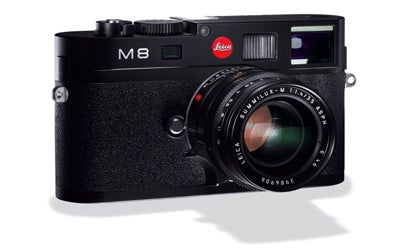Editor’s Choice 2007: Digital Rangefinders
We may earn revenue from the products available on this page and participate in affiliate programs. Learn more › An...

We may earn revenue from the products available on this page and participate in affiliate programs. Learn more ›
An impressive modern remake of a venerable camera concept, this model preserves the essence of Leica rangefinder design and operation in its great leap forward to digital capture. It allows Leica-loving 35mm photographers to shoot the way they always have — and get high-res digital image files.
Though the long-anticipated Leica M8 substitutes a 10.5-megapixel image sensor for the 35mm film used by its M-series counterparts, it looks and feels much the same as those classic rangefinders. It has their rounded, die-cast magnesium-alloy body, huge optical viewfinder, and M-type bayonet lens mount. There’s even a removable base plate — except that instead of giving you access to a film chamber, it covers slots for the M8’s SD card and Li-ion battery.
The transformation from film to digital required some fundamental changes, of course. These are most noticeable on the camera back, which has a bright, 2.5-inch, 230,000-pixel LCD screen surrounded by 10 buttons and a control wheel. (As with most D-SLRs, the screen isn’t “live,” so you use it only for image playback and menu navigation.) This simple layout provides immediate access to the top level of the onscreen menu, allowing you to check and change most settings quickly. The more familiar controls are in their customary places: the shutter-speed dial, shutter release, and frame counter on the top deck, the lens release and viewfinder frame line selector on the front. As usual with a Leica, these controls operate with a satisfying smoothness and precision.
Alas, there’s no silky film-advance lever. An integral motor cocks the shutter after each shot, causing slightly more noise than manual winding with a 35mm Leica rangefinder. The shutter-speed range is a wide 1/8,000 second to four seconds, plus B, with flash sync up to 1/250 second. You can set exposure manually using three LEDs below the viewfinder frame, or use aperture-priority AE.
Existing Leica M lenses from 16mm to 135mm, all prime, can be used on the M8 — manual focus only. Because the 18×27-millimeter sensor is smaller than a 35mm film frame, the focal length is effectively increased by a factor of 1.33. For example, a 28mm wide-angle lens becomes equivalent to a 37mm semi-wide in 35mm. The viewfinder displays frame lines to indicate the usable image area for lenses from 24mm to 90mm. (Shorter or longer lenses require a separate, non-focusing viewfinder that slips into the camera’s flash hotshoe.)
Electronic coding on recent Leica lenses signals lens information to the M8 so that the camera’s software can minimize vignetting, most apparent in the corners of wide-angle images. Leica can add coding to older M-series lenses, but even without it our vintage lenses didn’t produce noticeable vignetting.
Early users of the M8 complained about color anomalies in images of people wearing black synthetic fabrics. The problem is caused by the CCD’s cover glass, which is very thin for maximum image sharpness. The solution: a special UV/IR filter, two of which are now provided with the camera.